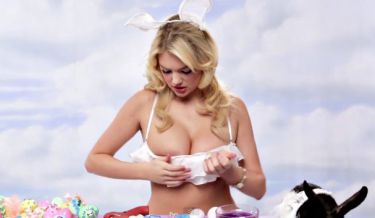April 8, 2012: How did we get from holy holiday celebrations to watching scantily-clad Kate UptonKate Upton bouncing around on Easter?
Long before the supermarket, eggs were once a seasonal commodity. After all in nature, birds (including early chickens) don’t lay eggs all year round. Their egg-laying cycles are usually regulated by amount of daylight.
In Europe, the bunny, which they call the hare, is a nocturnal animal. Until mating season that is, when there are bunnies all over the place, all day long.
When do these two events happen? They both occur just after the Vernal Equinox. Early chickens, if they were wild, would hide their eggs everywhere. So we have a Vernal
Equinox; chickens hiding eggs: and bunnies running all over the place.
Now the totem of Eostre, or goddess of the new beginning, was a hare. Put aside that every representation of her looks like a woman. As the story goes, Eostre comes upon an injured bird. She saves the bird by turning it into a hare, that being the animal she is strongest as. Because it is really a bird, this hare could still lay eggs. To show its gratitude to the goddess, the bird laid beautiful colored eggs on Eostre’s feast day ever since. The feast was held at the beginning of the Vernal Equinox
The whole thing gets blamed on the Germans, for there has always been the German Osterhase, or the “Easter Hare” translated to English. Let us put aside the Orthodox Christians adoption of the Julian calendar, which only adds confusion to the actual date of the Easter celebration. The custom was brought to America with the German settlers somewhere in the 1700s. Spice the whole thing with a little capitalism and there you go.

[youtube vBdWGD8F3Oo]










